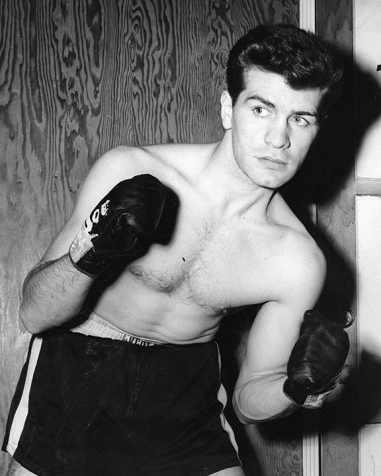Joe Miceli: The Enigma
By Dan Cuoco
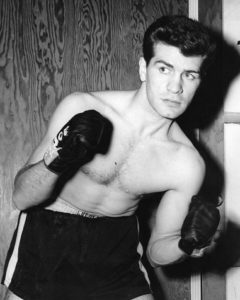 Joseph Anthony Miceli was born in Brooklyn, New York, on January 8, 1929. A converted southpaw, he became known for his murderous combination left- hook-uppercut, a weapon, when delivered on target, meant “lights out” for his opponent.
Joseph Anthony Miceli was born in Brooklyn, New York, on January 8, 1929. A converted southpaw, he became known for his murderous combination left- hook-uppercut, a weapon, when delivered on target, meant “lights out” for his opponent.
Miceli was one of the most popular fighters in boxing’s television era. He fought the best of three divisions, lightweight, welterweight, and middleweight, including twelve world champions, Ike Williams, Kid Gavilan, Gene Fullmer, Joey Giardello, Johnny Saxton, Virgil Akins, Johnny Bratton, Wallace (Bud) Smith, Don Jordan, Luis Rodriguez, Ralph Dupas, and Curtis Cokes. Of Miceli’s 111 bouts, 37 were televised, ranking him behind Kid Gavilan (47) and Tiger Jones (45) for the most bouts televised in the 1950s.
He was ranked as high as number three in the world welterweight top 10 from 1950 to 1956, but was never granted a world title bout. The main reason for that oversight was that he was one of the most uncontrollable fighters in the game throughout his entire career. He was the kind of fighter that drove managers stark-raving mad and made promoters neurotic. Harry Stickevers, his manager from 1953 to 1961, stated, “Instantaneous impulses govern Miceli’s whole life. Without reason, without warning, he is apt to fly off on some absurd tangent. When he gets the urge to play, nothing else is of any consequence.” In an interview with Robert Cassidy for Ring magazine, Miceli admitted as much. “My indifference to training limited my success. I used to smoke and stay out playing cards until two or three in the morning. The fights I lost were close fights, and it was because I ran out of gas in the late rounds.
No one will ever know how good a fighter Joe Miceli might have been; one can only analyze the known facts and then fill in the blanks with probabilities. Experienced trainers like Nick and Dan Florio, Whitey Bimstein, and Art Curley acknowledged that few fighters have had Miceli’s natural gifts. Dan Florio, his long-time trainer, stated, “He had everything except common sense. Guts and a left hook right out of the book. He could box like a Benny Leonard when he wanted to. Slip leads like a Lou Ambers and counter like a Billy Petrolle. When he was in shape, there wasn’t a welterweight in the world who could lick him, and there were dammed few middleweights around who could take him either.”
Further testimony of Miceli’s potential came from Tony Canzoneri. “When Joe is in there swinging, there is always the possibility that he’ll connect. And, then when he does, regardless of whether he is in or out of condition, the other guy will be knocked out.”
Time and time again, Miceli sprung Improbable Upsets
Time and time again throughout his checkered career, Miceli sprung improbable upsets like the night on October 2, 1950, when he outpointed lightweight champion Ike Williams in a non-title fight in Milwaukee, Wisconsin. In an interview with Robert Cassidy, Miceli stated, “I was 21 years old and I beat the champ of the world. I was shocked myself. He gave me a rematch, but never for the title.” Another improbable upset occurred on February 18, 1953, in Coral Gables, Florida, when Miceli upset favorite Bobby Dykes. Miceli was coming off back-to-back stoppages to Johnny Bratton and Gil Turner and had lost a decision to Dykes in Brooklyn, New York, just eight months prior. In an interview with Joe from 1959, he summed up his career beautifully. “Hell, some nights I got it, other nights I ain’t. I don’t know myself until the bell rings.”
Joe Miceli, the professional boxer
Joe Miceli grew up in New York’s Lower East Side, a neighborhood that produced Benny Leonard, Johnny Dundee, Sid Terris, Ruby Goldstein, Andy Thomas, Packey and Jimmy O’Gatty, Leach Cross, and many more. His introduction to boxing came at the intersection of Mulberry and Spring Streets. He honed his boxing skills as a street fighter and gained a reputation for being the toughest kid in his neighborhood. Joe took the advice of an old-timer and entered the amateur ranks in October of 1947, winning sixteen straight, twelve by knockout.
Four months later, on February 2, 1948, Joe Miceli, the street fighter, became Joe Miceli, the professional boxer, under the management of Bobby Nelson, and trainer Johnny Sullo. Like other fighters of his era, he started in four-round preliminary fights, eventually graduating to six and eight-rounders, before finally engaging in his first ten-rounder on April 15, 1949, with a record of 16-4-2 (KO 7). The combined record of his twenty-two opponents was 401-186-39. Among the fighters he defeated during this stretch were Mario Moreno (W-6), Jerry Meckler (TKO-6), Al Pennino (W-8), Joey Belifore (W-8), Johnny LaRusso (W-8), Willie Beltram (TKO 5), and Roman Alvarez (W-8). His fifth-round stoppage of Beltram earned him a semi-final with Roman Alvarez at Madison Square Garden, who he defeated on points.
On April 15, 1949, Miceli won a lopsided decision over Buddy Holderfield in the feature 10-rounder at St. Nicholas Arena. He hit too hard for his more experienced foe and dropped Holderfield for an eight count in the eighth round. He maintained his busy 1949 schedule with eight more fights, winning six, Freddie Menna (W-10), Roman Alvarez (W-8), Tommy Warnock (KO-2), Chuck Taylor (W-10), Fritzie Pruden (TKO-6), Billy Wyatt (W-8), losing two, Tony Pellone (L-10) and Frankie Abrams (L-10).
In 1950, Miceli stepped up the level of his competition and engaged in eleven fights, winning seven, losing three, and fighting one draw.
On January 13, 1950, Miceli knocked out Buddy Garcia in the first round of their eight-round scheduled semi-final at Madison Square Garden. Joe surprisingly stiffened Garcia with just one second to go in the first. Two weeks later, on January 27, 1950, he won on a technical knockout over Raoul Perez at the end of the seventh round at Madison Square Garden when Perez was unable to continue because of an injured right hand.
On February 25, 1950, Miceli was lucky to gain a draw against Charley Salas in their 10-round main event at Ridgewood Grove, in Queens. Salas outscored him frequently with left hooks and sharp rights to the jaw. There were no knockdowns. Miceli seemed off in his timing while Salas scored more sharply and more often, even though it was a close contest.
On March 25, 1950, Miceli stopped Tony Riccio in 1:06 of the fourth round of their ten-round feature at St Nicholas Arena. Referee Ray Miller halted the fight as Joe handed Riccio a fierce beating.
On April 21, 1950, Miceli lost a split decision to Johnny Saxton before a capacity crowd at St Nicholas Arena. The largest crowd in two years jammed the arena for the meeting of the two promising welterweight prospects. Miceli out-dazzled Saxton in the earlier rounds but wilted under Saxton’s wicked body punching and left-right combinations to the head. Saxton got off to a slow start in the bout but had Miceli down twice in the 7th and once in the 10th. Saxton was penalized in the fifth round for hitting after the bell. Referee Mark Conn and Judge Charley Shortell voted for Saxton, although they both scored the bout even in rounds. Conn gave Saxton 10 points to eight for Miceli, and Shortell had Saxton in front 12 to nine. Judge Bill Recht had Miceli the winner, five rounds to three with two even.
On May 10, 1950, Miceli TKO’d Joe DeFazio in the sixth round at St. Nick’s when referee Frank Fullam stopped the bout with DeFazio practically helpless. There were no knockdowns, but Joe took every round with ease.
On May 19, 1950, Miceli stopped Walter Haines in 2:26 of the first round of their ten-round semi-final. Referee Harry Ebbets halted the bout after Haines was floored three times.
On September 6, 1950, Miceli scored two knockdowns in the final round to gain a close split-decision over Sonny Boy West at the Arena in Milwaukee, Wisconsin. West appeared headed for victory until he ran into terrific right uppercuts that floored him for a compulsory eight count. West went down again from a left uppercut shortly after but was on his feet at the count of five. The bell ended the fight before Miceli could pounce on him. One judge voted 7-4 for West, with the others voting 7-6, 7-5 for Miceli.
On October 2, 1950, Miceli won an upset ten-round decision over reigning lightweight champion Ike Williams in a non-title fight. Joe began his attack early in the fight with fast and accurate left hooks. In the sixth round he had Williams on the ropes but didn’t seem to hurt him. Williams kept coming in when Miceli jolted him with more lefts in the seventh. Miceli caught Williams with a left in the ninth that put the champ on the ropes again but not for long. Williams fought back and was ready for his all-out try in the 10th. Miceli was tired in the last round, and Williams walked in looking for a knockout, knowing he was behind on points. Williams connected with a right and left that had Miceli hanging on the ropes, then poured on more left and right hooks. But Miceli came alive in the final half-minute and tagged Williams with three straight uppercuts to win a hard-earned unanimous decision. His victory over Williams moved him into the world welterweight ratings for the first time at number ten.
On November 23, 1950, Lightweight champion Ike Williams won a split decision over Miceli in a non-title bout that lacked most of the luster of their previous meeting when Miceli upset Williams. The 10-round bout in Milwaukee’s arena, before 5,728 fans, saw Miceli and Williams fall far below expectations. The fight was slow from the outset, with the pair content to make it a clutching affair through the first four rounds. Williams, who weighed 146 pounds, did most of the leading, but his punches curled or went over Miceli’s shoulders. Miceli weighed 145 3/5. The champ had two good rounds, the ninth and 10th when his right shook Miceli up and had him holding. A cut over Miceli’s left eye hampered him throughout the fight.
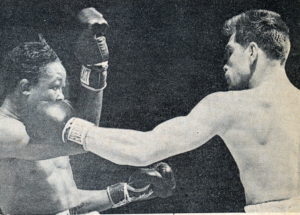
On December 22, 1950, Kid Gavilan, favored at 3-1, won a 10-round split decision over Miceli at Madison Square Garden. Jack Cuddy, United Press Sports Writer, reported, “Before Cuban Kid Gavilan gets another shot at the welterweight crown, he might have to lick young Joe Miceli again. Their exciting fight was so close that Referee Petey Scalzo, ex-featherweight champion, favored Miceli of New York six rounds to four. However, the two judges voted for Gavilan. After fighting his first Garden main event, Miceli surprised Gavilan and the year’s second-smallest Garden crowd with his speed, unusual ruggedness, and explosive left uppercut. He stunned the Cuban challenger in the first and 10th rounds and bloodied his nose, mouth, and right ear. In a see-sawing battle, Miceli won the first, fifth, eighth, and 10th rounds and fought on even terms in the second. However, the 22-year-old New Yorker absorbed severe punishment in the sixth and ninth sessions. Gavilan, master of the long “bolo” right uppercut, slowed his bouncing opponent with body smashes in the sixth and staggered him with a head barrage before that round ended. In the ninth, Gavilan staggered him with a right to the chin, then gashed his left brow with another right. Miceli’s left eye was nearly closed, and his right cheek was severely swollen at the finish of their excellent brawl”.
GI Joe
In 1951, Joe Miceli was drafted into the United States Army and only participated in four professional fights that year. Two occurred before his induction, and two occurred while on leave after his induction.
On January 22, 1951, Miceli won a ninth-round TKO over pre-fight favorite Arthur King of Toronto, Canada, in a ten-round bout at the Arena in Milwaukee, Wisconsin. King, the British Empire lightweight champion, was down for a nine-count in the fourth and seemed finished; but he managed to keep going until a series of left hooks left him unable to defend himself, and Referee Julius Fidler halted the bout.
On February 19, 1951, Miceli won his rubber match over Lightweight Champion Ike Williams. Although he emerged as a contender for the welterweight championship by punching Williams groggy, his momentum was put on hold. Miceli was scheduled for induction the night of the fight, but his draft board gave him a few days’ grace so he could fight. The 7,801 fans at the Philadelphia Arena stood and cheered as Miceli pounded Williams with his left hook-uppercut that landed on the champ’s face and body with sledgehammer force. The tenth round ended with Williams needing help from Referee Charley Daggert to find his corner, whereas Miceli looked like he could go ten more.
On May 5, 1951, Miceli, now a private stationed at Camp Atterbury, Massachusetts, fought a 10-round draw with Indianapolis Middleweight Champion Andy Anderson at the Indianapolis Armory in Indiana.
Five months later, on October 18, 1951, the pair met in a rematch in Grand Rapids, Michigan. Private Miceli scored a technical knockout over Anderson in the second round. He caught Anderson flush with a left hook early in the second round and dropped him. Anderson arose at the count of five, dazed. Referee Bobby Rings counted to eight, then allowed them to continue. Moments later, Miceli smashed the helpless Anderson with lefts and rights to the face and body, causing the referee to stop the fight.
On May 5, 1952, seven months after his last fight, Miceli was granted another leave and returned to the ring against tough Joey Giardello in Scranton, Pennsylvania. Giardello, and Miceli, now stationed at Camp Kilmer, N.J., battled to a widely disputed draw at the Watres Armory in Scranton, Pennsylvania. All three officials, Referee Jack Walton, Judges Capristo, and Joe “Reilly” Rabiega, rendered different verdicts. Rabiega called it a draw, while Capristo favored Giardello. Walton had the fight even in rounds but favored Miceli on the scoresheet. Under Pennsylvania Athletic Commission rulings, the result was an official draw. Miceli started very fast and won the first two stanzas. He appeared headed for a certain victory as he puffed up Giardello’s eyes. In the third round, Giardello started to come on. He won the third and fourth rounds with his cleaner punching. Miceli took the fifth. The sixth was slow, and either fighter did no damage. Giardello took command in the seventh, his best round. He took the eighth and ninth, but Miceli finished strong to win the final round. Throughout most of the fight, Miceli showed his lack of work by missing repeated left hooks. Nevertheless, he looked the part of a superior workman. Giardello came in at 153 pounds, Miceli, at 149 ½.
On June 2, 1952, Bobby Dykes won the nod of all three officials in whipping Private Joe Miceli in the 10-round feature at the Eastern Parkway Arena, Brooklyn. Dykes weighed 153 ¾, Miceli 148 ½. There were no knockdowns. Miceli brought blood from Dykes’ nose in the eighth round and, in turn, received a cut above the left eye. The seventh and eighth rounds were Miceli’s best sessions, but he seemed to tire in the ninth only to rally in the final chapter and slug it out with Bobby. Judge Joe Eppy scored six rounds for Dykes and four for Miceli. Judge Frank Fullum had it 5-4-1 and Referee Harry Ebbetts 7-2-1.
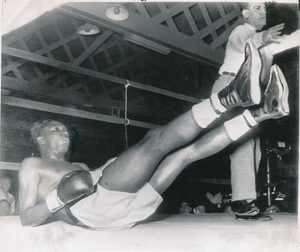
On June 30, 1952, Private Joe Miceli, 146 ½, scored an upset technical knockout over Luther Rawlings, 140, Chicago, at 2:37 of the second round of their widely televised 10-round bout at the Eastern Parkway Arena. Rawlings entered the ring a 7-5 favorite, but he never got going as Miceli swarmed over him from the opening bell. Miceli floored Rawlings twice during the first round by slamming left hooks to the body and head. He did not score a knockdown in the second round but was battering a helpless Rawlings against the ropes when Referee George Walsh halted the bout. It was a sharp reversal of form for Miceli from his last outing with Bobby Dykes.
On July 28, 1952, Miceli, now stationed at Camp Kilmer in New Jersey won a majority decision over France’s Pierre Langlois at the Eastern Parkway Arena. Miceli won on judge Steve Acunto’s card taking six rounds. Referee Pete Scalzo gave five rounds to each fighter, and Judge Ed Henry scored five rounds for Miceli, four for Langlois, and one even. There were no knockdowns, each fighter standing up under a steady barrage of punches. Miceli’s left eye was cut in the third but didn’t interfere with his left-handed agility. Langlois, a compact, durable welterweight, suffered a bloody nose in the ninth round when Miceli put on his closing rush.
On September 8, 1952, Private Joe Miceli scored a one-round knockout over Teddy Murray in their 10-round main event at Eastern Parkway Arena. Miceli dropped Murray with a left hook to the jaw for the count of nine. When Murray arose, barely beating the count, Miceli waded in and finished him off in 1:02. Two left hooks and a jarring right sent Murray down for keeps.
On September 30, 1952, Private Joe Miceli left-hooked his way to a unanimous 10-round decision over Virgil Akins at the Arena in Milwaukee, Wisconsin. Miceli, now stationed with the Army at Camp Kilmer, N.J., weighed 144 ¾ to Akins 138. Miceli, ranked sixth among the welterweights, was the boss from the first bell. There were no knockdowns. Akins, listed third of the lightweight contenders, speeded up in the late rounds, but his rally came too late. Miceli’s victory over Akins elevated him to number three in the world ratings.
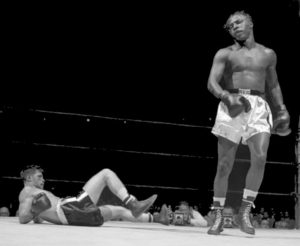
On October 31, 1952, Miceli received his first severe setback when he was stopped in the eighth round by ex-welterweight champion and number one rated, welterweight contender Johnny Bratton at Madison Square Garden. With blood streaming from a four-stitch gash in his right brow, Bratton gave an impressive performance and had Miceli so helpless after a thrilling brawl that referee Harry Kessler stopped the bout at 18 seconds of the eighth round. Entering the eighth, Bratton was slightly ahead on the official score cards. Bratton, scaling 148 pounds to Miceli’s 146, floored GI Joe once in the seventh. Unfortunately, it rang at the count of six, shortly after Miceli had lurched to his feet, unsteady and ready to be taken. Instead, Bratton “took him” quickly in the eighth with a right, left, right combination to the chin that knocked Miceli into the ropes and left him staggering about the ring with Bratton in deadly pursuit. Then the referee stepped in. Bratton also staggered Miceli in the second and sixth sessions, but Bratton also absorbed punches that had him on rubber legs in the third and fourth rounds. It seemed that the 2-1 underdog was about to achieve an upset. Miceli’s left hooks and left uppercuts opened the gash in Bratton’s right brow in the fourth round. Miceli made such an excellent showing against his more experienced opponent that he asked for a rematch.
On December 22, 1952, Miceli’s career took another turn for the worst when Gil Turner stopped him in the sixth round of a scheduled 10-rounder at the Philadelphia Arena. Turner pounded Miceli with body and head blows until he was so helpless that Referee Pete Tomasco halted the action at 58 seconds of the sixth round.
A Return to Civilian Life and Another Improbable Upset
On February 18, 1953, Miceli pulled off another improbable upset when he defeated number one-ranked welterweight contender Bobby Dykes in a nationally televised fight in Coral Gables, Florida. He was coming off back-to-back stoppages to Johnny Bratton and Gil Turner and had lost a decision to Dykes in Brooklyn, New York, just eight months prior. “Miceli, a 3-1 underdog, was the aggressor and battered Dykes with his pet punch, a left hook-uppercut. Miceli piled up a lot of points in the early sessions as his unorthodox punch and aggressiveness confused the straight stand-up Miamian. Dykes started to come on in the later rounds when Miceli slowed down quite a bit. That strong finish earned him the vote of Judge Gerry Sherrard, 97-94. Mark Erwin voted for Miceli 97-96, and Referee Bill Regan called it 97-93 for Miceli. The victory elevated Miceli to the number four spot in the world ratings.
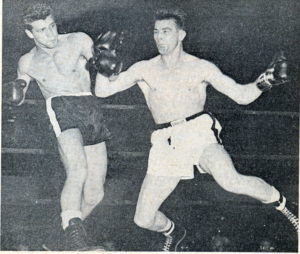
On April 15, 1953, Pierre Langlois survived two early knockdowns to defeat Miceli in a nationally televised fight at Miami Beach. Miami’s scoring system and Miceli’s overconfidence helped Langlois earn his decision. Under Miami rules, fights are judged strictly by rounds, with no consideration for the margin of victory in any round. So Miceli got no more credit for the rounds he won on knockdowns than Langlois did for the ones he managed to win later by a punch or two. Langlois, a 7-to-5 favorite, weighed 158 ½, and Miceli came in at 150. The loss dropped Miceli to number five in the world ratings.
On May 26, 1953, Johnny Saxton used a punishing body attack and landed enough shots to the head to preserve his perfect record with a unanimous decision over Miceli at the Olympia Stadium in Detroit. Saxton, a slight favorite, weighed 147 ¾ to Miceli’s 147 ½ . The action became so furious that both fighters fought after the bell rang in the fourth and eighth rounds. Saxton piled up what appeared to be a safe lead over the first seven rounds. But Miceli, refusing to quit, fought back and almost pulled it out with a few flurries in the late rounds.
Is Joe Miceli about to Retire from The Ring
On July 7, 1953, Miceli lost a lackluster ten-round decision to Irvin Steen at Ridgewood Grove in Brooklyn. The Brooklyn Daily News headline read, “Is Joe Miceli about to retire from the ring”? Manager Bobby Nelson, who has guided Miceli since he turned pro, said he is seriously considering retiring Joe after his poor showing against Steen. “It was his third straight loss,” Nelson said, “and I’m convinced he’s not going anywhere. We are contracted to fight Johnny Saxton in Milwaukee on July 27, but if Promoter Phil Valley wants a release, it’s O.K. with me. I wouldn’t be doing Miceli any good putting him in against Saxton after tonight’s performance.” Miceli said his poor performance was due to the heat under the ring lights. “I moved fast in the gym and had plenty of road work,” Miceli claimed. “I was in good shape, but the heat got to me. My corner told me I’d have to knock him out to win after the seventh, but I couldn’t get my arms up. I went in at 145 and weighed 140 pounds after the fight. It’s the first time the heat bothered me.”
The last straw for Nelson was when Miceli lost his next fight to underdog Pat Manzi by TKO from a cut over the eye in the sixth round of a scheduled 10-rounder in Syracuse on August 18, 1953.
A New Beginning with Harry Stickevers
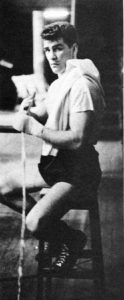
Harry Stickevers bought Miceli’s contract in September 1953, knowing it was a gamble. He stated, “Miceli had been fighting for five years, and he had some good fights. He fought Kid Gavilan, Joey Giardello, Johnny Bratton, Gil Turner, Ike Williams, and many other better-name fighters. Yet he was unhappy with his contractual arrangements and didn’t make any money. When I took him over, he didn’t have a dime and was a discouraged kid. He had lost his confidence and was sure he wouldn’t fight anymore. With that attitude, he couldn’t fight. In his case, he had nothing to lose. We – the Florio boys, Nick and Dan – told him what we had in mind and asked him if he wanted to sweat it out. He said he would. I made him no promises. We put him through a torturous training routine for eight weeks, never letting up the entire time. We ran him until his tongue hung out, and his legs felt like logs. We made him box until his arms hung by his side. He was so tired by supper time he could hardly eat and fell into bed exhausted. The next morning, he was up before dawn to start his road work. It was relentless and cruel. He couldn’t see his family. He didn’t see any friends. He just kept going, going, going. It was lonely and rough. But if he could survive that, it was time to think of fighting. Never once, either before or during training, was a fight mentioned. Joe could only hope he would pass the test. If the Florio’s and I weren’t satisfied, he would have to continue the grind or be dropped. Finally, we thought he was ready, and we started training for a fight. What went before was just conditioning. We took him to Holyoke for no money and put him in with Jesse Keeler. He knocked Keeler out, regained his confidence, and started to go. He has won three since and is beginning to make money. There’s still a long way to go. But how many would go through it?”
On January 4, 1954, Miceli made his first ring appearance in seven months and knocked out Jesse Keeler in the second round at Valley Arena in Holyoke, Massachusetts. Twenty-six days later, he knocked out Wes Echols in 32 seconds of the third round in Richmond, California.
On February 20, 1954, Miceli pulled off another improbable upset when he knocked out lightweight contender Wallace (Bud) Smith with a perfect picture-book left hook midway in the fifth round at the Music Hall Arena in Cincinnati to hand the local favorite his first knockout defeat of a six-year career covering 41 fights. The fight ended in dramatic suddenness at 1:19 of the fifth. Miceli, a slight underdog despite a six-pound weight advantage, 147 to 141, carried the fight all the way, thanks to his effective left hook-uppercut that found Smith’s head with alarming regularity. Smith charged out for the fifth, knowing that his move must be made now or never. He tied Miceli up in a corner and riddled him with a flurry of body blows that, for a moment, appeared to slow Miceli down. And for the first time, Miceli’s arms sagged slightly. But before Smith landed another blow, Miceli uncorked his left hook, which caught Smith flush on the jaw. Smith stepped back a half pace, then toppled to a prone position flat on his back. Referee Tommy Warndorf tolled to eight, and Smith made a valiant effort to roll over and regain his feet. But all his strength was gone. A quarter of an hour after the knockout, Smith was still groggy to give any first-hand explanations. The win elevated Miceli to number eight in the welterweight world ratings.
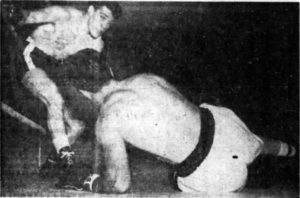
On March 13, 1954, Miceli returned to Cincinnati and defeated Johnny Lombardo in a furious 10-rounder. A month later, he traveled to Boston, where he spoiled New England Welterweight Champion Steve Marcello’s aspirations by flooring the local youngster four times before referee Jimmy McCarron stopped the fight at 59 seconds of the sixth round.
On May 29, 1954, Seventh-ranked welterweight contender Al Andrews and Miceli fought a rugged draw at the Indianapolis, Indiana Fairgrounds that gave a national television audience its first taste of round-by-round-scoring announcements from the officials. Andrews weighed 150 ¼, Miceli 152 ½. Miceli took command in the first two rounds, flooring Andrews with a left hook for a count of five in the first. Andrews rallied with a body attack and brought the fight even at the end of four. Both corners apparently heeded the announced scores, and both fighters circled most of the fifth round in the middle of the ring. The fight see-sawed, with Miceli holding a slight edge. Judge Tony Coppi scored it Miceli 95, Andrews 93, Judge Van Smith scored it 95-95 even, and Referee Tony Zale gave Andrews 97, Miceli 96 on the 10-point must system.
On June 19, 1954, Miceli lost a 10-round split decision to Toledo’s Pat Lowry at the Sports Arena in Toledo, Ohio. Miceli scored well in the first four rounds with a left hook but slowed in the later stages. He noticeably favored his left hand in the last stages of the bout. After the fight, the hand was severely puffed, and Miceli said he hurt it in the first round and that it pained him the rest of the way. The hand was x-rayed, forcing him to cancel his next fight scheduled for Miami, Florida.
On September, 11, 1954, Miceli squeaked out a 10-round split decision over Wallace (Bud) Smith at the Music Hall in Cincinnati in an exciting fight full of ebbs and flows. Miceli, who had been out of action for three months, weighed 147, six-and-a-half pounds more than Smith. Looking very sharp in the early rounds, Miceli opened a gash alongside Smith’s eye in the fourth, nearly closing it tight. He was clearly the master of the first four rounds, but after Smith took the fifth, the action slowed, and the local boy came on strongly in the late stages. With Smith’s eye nearly closed and the tremendous pace slowing, Bud appeared to change tactics. Staying close, he caught Miceli with short left jabs as he advanced and opened a cut over Miceli’s left in the sixth as he apparently tired. Bud got his second wind in the eighth and landed his best blows – two left hooks and a right cross midway in the round. But Miceli scored with a wild left late in the stanza that shook Smith. Smith, moving in close in the ninth, was caught time and time again with Miceli’s straight lefts and rights that won him the round. But Bud looked strong in the 10th when he appeared to hurt Miceli, bulling his way in close and landing both hands. Gene Nitske had Miceli ahead 96-95, and Joe Blink saw it 95-93 for Smith. Joe Craven’s ballot, however, showed a wide difference of 98-91 in favor of Miceli. The fight was televised nationally but blacked out in the Cincinnati area. The referee was Tony Waldorf.
On November 18, 1954, Bob Stecher held Miceli to a draw at the City Auditorium in Omaha. Stecher, at 159 pounds, appeared to be wearing Miceli down in the middle rounds, but Miceli, 153 pounds, rallied with a hit-and-run attack late in the fight. Miceli suffered a gashed forehead in the third when they bumped heads. But he was too elusive, and Stecher never managed to follow up the advantage. The fight was ruled a draw by Referee Alex Fidler.
On December 11, 1954, Peter Mueller, Germany’s clown prince of boxing, forgot the funny stuff to win a unanimous decision over Miceli before a capacity crowd of 13,909 at Boston Garden in a nationally televised bout. Mueller crowded him from bell to bell to win a workmanlike decision. Only in the sixth, eighth and final round did Miceli come close to solving Mueller’s awkward-appearing style. Mueller, at 155 pounds, had a seven-pound weight advantage over Miceli.
On January 15, 1955, Miceli came up with a belated rally to earn a 10-round draw with Italo Scortichini in a nationally televised main event from Dinner Key Auditorium in Miami. Miceli ruled the early rounds, and after permitting Scortichini to take the lead through the middle rounds, he came up with his rally. Miceli’s surge featured left hooks and an occasional right. Scortichini was teeing off on Joe in rounds 6, 7, and 8 with overhand rights, but Italo, the 5-2 favorite, let up in the final two rounds. The early rounds were close as both fought toe-to-toe on almost even terms. However, Miceli’s left hands gave him the early rounds, and his southpaw clouts won him the final two rounds.
On February 7, 1955, Clever Jimmy Martinez outpunched Miceli to gain a ten-round split decision at Edgerton Park Arena in Rochester, New York. Martinez weighed 154; Miceli weighed 149 ¼. Martinez, who jabbed his way to domination in the last two rounds, was voted the winner at 5-4-1 on the cards of one judge and the referee. The other judge called it 5-3-2 for Miceli.
On March 7, 1955, Gil Turner scored a technical knockout over Miceli in 44 seconds of the eighth round at the Eastern Parkway Arena. Turner weighed 155 ½ pounds, Miceli 147. Referee Petey Scalzo stopped the bout as Turner kept pegging away at Miceli’s left eye, which was cut about the brow and almost closed. The eye was cut in the fourth round, and Dr. Samuel Swetnick examined the wound at the end of the sixth but permitted the bout to continue. Miceli made a whirlwind start, exploding left hooks and left uppercuts in the first round, which twice stunned Turner. Miceli’s speedy delivery appeared to give him a slight edge in the second, but Turner’s vicious body belts began to slow Miceli’s attacks after that.
On April 21, 1955, Miceli battered out a 10-round decision over Luther Rawlings in a savage battle at the Kiel Auditorium in St Louis that saw Rawlings lose a chance for a draw when he had the fourth round taken away for two low blows. In their first meeting in 1952, Miceli stopped Rawlings in the second round.
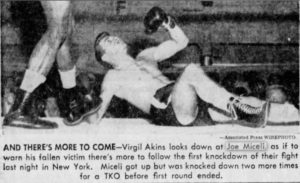 On May 23, 1955, Virgil Akins scored a technical knockout over Miceli by flooring him three times in the first round at St. Nicholas Arena. Akins registered the stoppage at 2:41 of the first round when Referee Ray Miller invoked the three-knockdown rule. Akins, scaling 145 pounds to Miceli’s 148 ½, dropped Miceli with a jolting left hook. Miceli got up at three, shaking his head to clear away the cobwebs, and was given the automatic eight count. A solid left to the body dropped Miceli again, but he jumped up at one and waited out the eight count. Eager for the kill, Akins tore into Miceli and decked him for the third and last time with a short right to the jaw. “A left hook to the body paralyzed me, and I couldn’t catch my breath,” said Miceli. “I don’t remember what happened after that.” “The hook to the body set him up,” said Akins. “Lou Gross told me to go for his body. It worked.”
On May 23, 1955, Virgil Akins scored a technical knockout over Miceli by flooring him three times in the first round at St. Nicholas Arena. Akins registered the stoppage at 2:41 of the first round when Referee Ray Miller invoked the three-knockdown rule. Akins, scaling 145 pounds to Miceli’s 148 ½, dropped Miceli with a jolting left hook. Miceli got up at three, shaking his head to clear away the cobwebs, and was given the automatic eight count. A solid left to the body dropped Miceli again, but he jumped up at one and waited out the eight count. Eager for the kill, Akins tore into Miceli and decked him for the third and last time with a short right to the jaw. “A left hook to the body paralyzed me, and I couldn’t catch my breath,” said Miceli. “I don’t remember what happened after that.” “The hook to the body set him up,” said Akins. “Lou Gross told me to go for his body. It worked.”
On August 4, 1955, Miceli won an upset 10-round unanimous decision over Art Aragon before nearly 10,000 fans at Los Angeles’ Olympic auditorium after cutting Aragon’s face into a bloody mess with a steady flurry of hard left hooks and uppercuts. The Golden Boy, who fought with a broken right ankle from the fourth round, went down twice during the bout where he had been the 2-1 favorite. His ankle snapped when he was floored from a right to the jaw for an eight-count in the fourth round. But Aragon kept on fighting. Aragon’s face was a bloody mess at the end of the fight, and he was almost blind because of swollen eyes. Sportswriters expressed the opinion Miceli probably could have “put away” Aragon in the final round but did not out of pity for his bloody and beaten foe who, at that point, appeared his easy prey. Miceli said he did not think Aragon was “washed up.” “They said that about me once,” he said.
Two week later, Don Jordan, 143 ½, California lightweight champion, stepped up in class and hammered out a unanimous upset 10-round decision over Miceli, 147 ½. at the Olympic auditorium before 6,733 fans. Miceli was forced to take off a pound and one-half prior to climbing into the ring.
On October 6, 1955, Miceli won a wild, unanimous 10-round decision over fourth-ranked welterweight contender Ramon Fuentes at the Winterland Arena in San Francisco after he knocked the Los Angeles fighter down three times and had him on the verge of a kayo late in the fight. Joe used his vaunted left hook to advantage as he decked Fuentes for an eight count in the second round and clubbed him to the canvas twice more in the seventh. After the third knockdown, he backed Fuentes into a corner and pounded him with a barrage of blows but lacked the steam to put him away. Miceli, outweighed 149-154 1/2, suffered a cut under his right eye from a left hook in the fifth round and appeared to be tiring after building up a big lead. The win once again vaulted him back into the world ratings.
But just six weeks later, Ramon Fuentes, 150 ¾, exacted revenge by scoring an easy unanimous decision over a lethargic Miceli, 149, at the Olympic Auditorium in Los Angeles. Fuentes captured every round of the dull fight, outpointing Miceli with a steady attack of powerful lefts.
The erratic Miceli started the new year, January 17, 1956, losing an upset 10-round unanimous decision to Miami’s Jimmy Morris at Miami Beach Auditorium. Morris nailed him repeatedly with stiff left jabs and chopping rights. In contrast, Miceli could not land his blows solidly.
On February 7, 1956, the unpredictable Miceli was hot again, jabbing and hooking his way to a unanimous 10-round decision over undefeated Stan Harrington at Honolulu Stadium, Hawaii, before the largest crowd to witness a fight there in recent years. The attendance was 8,495, which was cut down somewhat due to rain in the afternoon. Miceli outboxed the local favorite employing his left effectively throughout the battle. His speed enabled him repeatedly to beat Harrington to the punch with left hooks to the head and to move out of the Island battler’s potent punches.
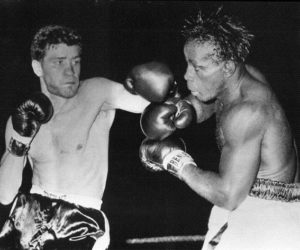
On April 27, 1956, Miceli gave Cuban welterweight title contender Isaac Logart a bad beating during the early rounds, but Logart came on strong in the later rounds to win a unanimous decision at the War Memorial Auditorium in Syracuse. Logart was punished badly during the fourth, fifth, and sixth rounds by Joe’s hard left uppercut. A cut over the corner of Logart’s eye opened in the fifth round. Logart was concerned over the fans’ loud booing when the decision was announced. Miceli appeared shocked at the decision. “I thought I won easily,” he commented.
On July 4, 1956, Miceli tired badly in the late rounds, losing a unanimous 10-round decision to Maurice Harper in Oakland, California. Miceli slugged his way into an early lead and sliced Harper’s left eyelid in the first round. Harper closed the gap with superior boxing and finished stronger.
On September 10, 1956. Miceli returned to his winning ways, flooring Arthur King for a mandatory eight-count in the fourth round at Maple Leaf Gardens in Toronto, and went on to win a split decision in their 10-round bout. It was his second victory over King. In their first meeting in 1951, he stopped King in nine rounds.
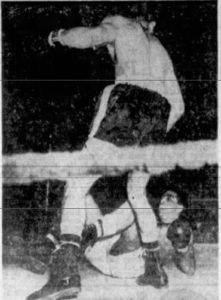
On October 8, 1956. Miceli pulled off another improbable upset, winning a decisive unanimous decision over 4-1 favorite Danny Giovanelli in a nationally televised 10-rounder at St. Nicholas Arena. He belted Gionanelli repeatedly with left hooks and left jabs, dropping him in the second round. Giovanelli was up at two, took the mandatory 8-count from Referee Ray Miller, and more punishment during the remainder of the bout. At the finish, Giovanelli was battered around the eyes. Miceli was just a little winded. (Photo: Miceli vs Giovanelli)
On October 31, 1956, Miceli, now the tenth-ranked welterweight, easily pounded out a 10-round decision over Carlo Sarlo in a televised bout from Chicago Stadium. Miceli showed his experience from the first round. He constantly feinted Sarlo into futile jabs and defensive gestures and landed steadily with left jabs and hooks. His two-fight winning streak returned him to ninth in the ratings.
In 1957, Miceli engaged in nine fights going 5-4. On March 7, 1957, tenth-ranked welterweight contender Charley (Tombstone) Smith hooked and jabbed his way to a unanimous decision over him in Los Angeles. Smith weighed 150, Miceli 149. Joe was a 2 ½-1 underdog and well aware why: he was several inches shorter than his 6-foot opponent. Joe started as if it were a street brawl. He threw several roundhouse rights and hooked in with some solid lefts. But Smith handled him easily, finding him repeatedly with a long jab. It was Smith’s fight from the opening bell, and he got the nod on all three cards. The loss dropped Miceli from the world ratings.
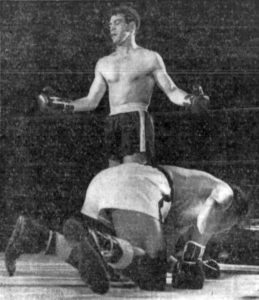
On April 9, 1957, Miceli stopped Chris Dundee’s “house fighter” Jose (Rocky) Flores in the sixth round at Miami Beach. For all intents and purposes, the fight ended early in the first round. Flores was dropped three times in the first round alone, sufficient to end the contest. However, referee Cy Gottfried let the fight continue before finally stopping the one-sided fight in the sixth round.
On April 29, 1957, Middleweight Jackie LaBua took full advantage of an eight-pound weight advantage to hammer out a unanimous decision over Miceli in their nationally televised fight at St. Nicholas Arena. LaBua was in command most of the time and used his weight advantage wisely in close-quarter fighting. Jackie outpunched the sluggish Miceli at least three to one.
On May 18, 1957, Miceli scored a technical knockout over Cuban welterweight champion Miguel (LaDiabla) Diaz, of Cuba, at 2:55 of the sixth round of their scheduled 10-round fight at the Palacio de Deportes in Havana, Cuba.
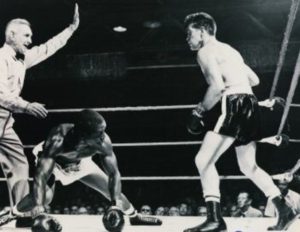
On September 6, 1957, Miceli jolted Johnny Saxton’s comeback campaign by winning a fourth-round technical knockout in Washington D.C. Saxton, a 2-1 favorite, outweighed him, 153 ½ to 147 ½. He floored Saxton twice – once in the first round with a surprise right and again in the third with a blistering left. Ring physician Clark Halstead called off the fight after examining Saxton at the end of the third round. Saxton bled heavily from the mouth and was glassy-eyed.
On September 18, 1957, Quick-moving Ralph Dupas of New Orleans kept Miceli guessing most of the time and boxed his way to an easy 10-round decision at the Coliseum Arena in New Orleans. Dupas, the third-ranked lightweight contender, weighed 142 ¼, Miceli 145 ½.
On October 11, 1957, Isaac Logart, the second-ranked welterweight contender for the title vacated by Carmen Basilio, improved his chances by easily defeating Miceli at Olympic Stadium in Detroit. He stabbed Joe with stinging jabs, thudded powerful hooks against his head, and generally won just about as he pleased in their 10-round nationally televised contest.
On November 4, 1957, Miceli won a majority decision over Ramon Fuentes in a ten-round feature at the Civic Center in Honolulu, Hawaii. The victory was his second over Fuentes in three meetings. Joe proved too fast for the California Mexican. He ripped into Fuentes repeatedly with a left hook to the head and avoided his frantic efforts to get him to come in and nail him.
On January 1, 1958, Charley (Tombstone) Smith stopped Miceli at the end of the seventh round at Madison Square Garden. Smith never did drop him but had him gasping in the late rounds. Joe had the edge in the first three rounds cutting Smith over the right eye. In the fourth round, Smith took control as Miceli tired and controlled the action through the end of the seventh round. The referee stopped the bout at the end of the seventh round, as Miceli could barely finish the round on his feet.
On March 8, 1958, Miceli proved he wasn’t entirely ready for the discard heap at Hollywood Legion Stadium when he finished with a violent flourish to cop a unanimous 10-round decision over favored Karl Heinz Guder of Essen, Germany, in the televised main event. He dropped the 23-year-old Guder twice in the final round to sew up what had been a close scrap through nine rounds.
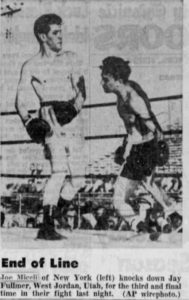 On June 4, 1958, Miceli gave young welterweight Jay Fullmer a rude welcome to big-time boxing, scoring a third-round knockout at West Jordan Park, West Jordan, Utah. Miceli weighed 147 to Fullmer’s 140. It was the first time former Middleweight champion Gene Fullmer’s 21-year-old brother had lost in fourteen professional starts. Miceli calmly waded into Fullmer’s brief rushes in the first two rounds, watching for an opening. Instead, he found it in the third and belted Fullmer into the ropes with a vicious left hook. Fullmer didn’t actually hit the deck as he floundered for his footing, but referee Ken Shulsen counted it as a knockdown and waved him away. Moments later, Miceli landed another left hook that sent Fullmer to the canvas in a slow sag. As young Fullmer got up, glassy-eyed, he waded into a left uppercut that sent him sprawling, and referee Shulsen called the kayo at 2:09 of the third.
On June 4, 1958, Miceli gave young welterweight Jay Fullmer a rude welcome to big-time boxing, scoring a third-round knockout at West Jordan Park, West Jordan, Utah. Miceli weighed 147 to Fullmer’s 140. It was the first time former Middleweight champion Gene Fullmer’s 21-year-old brother had lost in fourteen professional starts. Miceli calmly waded into Fullmer’s brief rushes in the first two rounds, watching for an opening. Instead, he found it in the third and belted Fullmer into the ropes with a vicious left hook. Fullmer didn’t actually hit the deck as he floundered for his footing, but referee Ken Shulsen counted it as a knockdown and waved him away. Moments later, Miceli landed another left hook that sent Fullmer to the canvas in a slow sag. As young Fullmer got up, glassy-eyed, he waded into a left uppercut that sent him sprawling, and referee Shulsen called the kayo at 2:09 of the third.
On August 1, 1958, Miceli thought he got a bad deal when he lost a 10-round unanimous decision in Syracuse after flooring Yama Bahama twice in the first round. He based his argument on the fact that Bahama went into a bear-hugging routine after the two knockdowns. “He should have been disqualified in the first round,” Joe shouted. Miceli sent Bahama to the canvas with a crushing left uppercut with the first punch of the fight. Bahama grabbed and tackled him about the ring. Later in the round, Miceli dropped the glassy-eyed Bahama again, but he arose and survived the round. Bahama dropped Miceli for a short count in the eighth, and the best Miceli could do after that was flail away with his favorite looping left hand.
On September 16, 1958, Hawaiian Welterweight Champion Stan Harrington won a unanimous 10-round decision over Miceli in the feature bout at the Honolulu Stadium. The victory avenged a 1956 defeat at the hands of Miceli at the Stadium. Harrington was the picture of confidence as he outhit and outclassed him. He used stinging left hooks and straight left jabs to beat Miceli at his game. Miceli’s vaunted left hook was held pretty much in check. The fight was a complete reversal of their first meeting when Joe closed Harrington’s eye in winning a lopsided decision in March 1956.
On October 11, 1958, Miceli stopped Germany’s Karl Heinz Guder in the eighth round of their 10-rounder at Hollywood Legion Stadium. He nailed Guder consistently with his left in every round and had Guder’s nose bleeding from the second round. Guder also had a cut under his left eye when referee Tommy Hart stopped the fight at 1:37 of the eighth round.
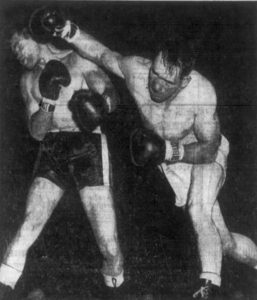
On November 10, 1958, Gene Fullmer kayoed Miceli in the second round. The Salt Lake Tribune reported, “In a slam-bang exhibition of unleashed slugging fury, Gene Fullmer blasted Joe Miceli into fistic oblivion with a second-round knockout before 4,300 partisans in the Coliseum in Salt Lake City. The end came at 38 seconds of the second round as Fullmer, switching to an overhand volley-type of swinging, slammed Miceli to the canvas. Miceli, who set up this grudge match with a third-round kayo of Jay Fullmer last summer, was not in the contest with the former world’s middleweight champion after a brisk flurry in the first round. Miceli was down for a nine count, down on one knee for no-count, and groggy on the ropes – all from overhand rights – in the first round. In the second, Fullmer faked to the body and whistled another overhand right, and Miceli went down like a pole-axed steer. He was trying to get up as Referee Ken Shulsen counted “10.” Fullmer weighed 159, Miceli 153″.
A Long Hard Career Takes Its Inevitable Toll
Miceli opened his 1959 campaign by losing three consecutive fights in a period of 26 days. On January 27, 1959, he watched his chances for a non-title bout with welterweight champion Don Jordan go by the wayside after dropping a unanimous decision to unknown Dave Johnson in a dull 10-rounder at the Oakland Auditorium. He had been promised a match with Jordan by Promoter Don Chargin if he defeated Johnson. But the San Francisco fighter, a 2-1 underdog, provided what action there was and outpunched him the entire fight. Then, on February 10, 1959, L.C. Morgan used speed, a stinging left jab, and solid counterpunching to decision him at Madison Square Garden in Phoenix, Arizona. Miceli admitted after the fight he felt sluggish after the seventh round. Eleven days later, on February 21, 1959, Cuban welterweight champion Luis Manuel Rodriguez stopped him in the fifth round of a scheduled 10-rounder in Havana, Cuba. Miceli took a heavy battering in the third and fourth rounds and went down without being hit at the start of the fifth. However, he got to his feet and was hit by two solid rights before the referee stopped the bout at 1:20.
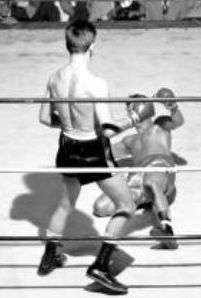
The last improbable upset of Joe Miceli’s career occurred on April 25, 1959, when he ended Art Aragon’s dream of a title fight with Don Jordan by winning a close bruising unanimous 10-round decision to 5-1 favorite Aragon before a turn-away crowd of 6,500 at Hollywood Legion Stadium. Miceli weighed 148, Aragon 152. Miceli, lashing out with left hooks that originated from the area of his kneecaps, brought the crowd to its feet early in the first round when he tore after Aragon with both fists blazing. Aragon, taken by surprise, went into a quick retreat and while going back caught a left hook to the jaw and a long right that spilled him for an eight count. Miceli went all out for a knockout but was unable to get over the finishing punch, although he had the Golden Boy stunned repeatedly. Aragon surprised the fans by coming back to out-left hook Miceli in the second stanza, but Miceli was on target again in the third round. With a vicious left hook, he decked Aragon as if he was pole-axed. Aragon got up badly hurt at four and took a severe lacing for the remaining minute of the round. A Miceli left hook almost floored Aragon again at the bell, and he walked aimlessly away from his corner when the bell sounded. Aragon was in bad shape. Miceli toyed with Aragon in the fourth and fifth rounds but never went after him as ferociously as he did in the first three rounds. The sixth round was Aragon’s big round. He hit Miceli over the eye with a right which opened a cut and followed with a barrage of lefts and rights which staggered him. The seventh, eighth, and ninth rounds were all Aragon. Miceli’s cut eye gave him trouble, and he appeared to tire badly. The tenth was a torrid affair. Aragon, realizing he would have to kayo Miceli to win, went all out. However, Miceli counter-punched beautifully and hit Aragon with a left hook that dazed and almost floored him. Aragon tried to hold but Miceli pushed him away and was landing punches with both hands when the bell ended the fight. Referee Tommy Hart voted for Miceli 89-88. Judges Mushy Callahan and George Latka had Miceli ahead 92-90 and 93-89, respectively.
Although his win over Aragon was impressive, Miceli would only engage in seven more fights in his career, from July 1959 to January 1961, going 1-5-1.
On July 25, 1959, Jorge Fernandez stopped Miceli in the seventh round at Luna Park in Argentina. Fernandez suffered a no-count knockdown in the first round, but Miceli sustained a severe cut to his right eye in the second round. The cut bled continuously, forcing the referee to stop the fight at 55 seconds of the seventh round.
On September 12, 1959, Pat Lowry knocked out Miceli in the eighth round at Hollywood Legion Stadium. Miceli got off to a fast start and shook Lowry several times with his left hook, but his lack of conditioning caught up with him in the fifth round, and he began to tire and was in retreat for the remainder of the fight. Finally, in the eighth round, a right hand to the jaw sent Miceli down for a three count. After he got up, he was floored for the ten-count by another right hand.
Ten days later, Miceli was involved in a fight with a strange ending with Mel Barker in San Antonio, Texas. The fight was shaping up as a slam-bang affair when Barker unintentionally butted Miceli’s left eye. Dr. Bernard K. Weiner examined Miceli between the third and fourth rounds and said Miceli had a spasm in the pupil of his left eye and wouldn’t let him continue. Consequently, the fight was ruled a technical draw.
On December 15, 1959, Undefeated Buffalo middleweight Rocky Fumerelle won a unanimous 10-round decision over Miceli at the Memorial Auditorium in Buffalo. Fumerelle weighed 155 pounds, four more than Miceli, and used this to his full advantage in the late rounds. Miceli took an eight-count in the fifth round after the two fighters appeared to have butted heads. Both fighters had cuts in the collision.
On February 16, 1960, Miceli won a unanimous decision over Gene Tortorice of Niagara Falls at the Memorial Auditorium in Buffalo. Gene made it close with swinging shots to the head, but Miceli’s uppercut and his ability to make Tortorice miss proved the difference. In the third, a left to the jaw dropped Gene for a mandatory eight-count.
On May 10, 1960, Miceli, now a shadow of his former self, lost by TKO to Trenton, New Jersey middleweight Mel Collins at the Moose Hall in Trenton after 2:45 had elapsed in the third round. The Trenton Evenings Times wrote, “Miceli couldn’t even defend himself from the onrushing Collins and failed to land a solid blow. A left and right combination by Collins dropped Miceli in his own corner, and Referee Paul Cavalier stepped in and stopped the one-sided affair. Collins continually beat Miceli to the punch in the opening round, and in the second, a hard right hand to the chin sent Miceli to the canvas. The count reached four when the bell rang. Miceli, 31, weighed in at 154, and Collins, 26, scaled 157 ¾. It was a sad ending to a thirteen-year career for Miceli that included wins over well-known ring men such as Johnny Saxton, Jay Fullmer, Art Aragon, Wallace (Bud) Smith, Pierre Langlois, Bobby Dykes, and Virgil Akins. While the knockout of Miceli will look good in the record book for Collins, the New Yorker appeared so ring-worn and flabby that there was little prestige that the Trenton youngster could gain in the bout”.
Nine months after his crushing defeat to Mel Collins, Miceli made his final ring appearance on January 16, 1961, in Dallas, Texas, against Dallas welterweight Curtis Cokes. Cokes, 147, ended the 149-pound Miceli’s comeback hopes by taking a unanimous decision after twice flooring him in the ninth round.
After his boxing career ended, he was an active member of Ring 8, New York City’s chapter of the Veterans Boxing Association, which honored him as the “Uncrowned Champion,” presenting him with a belt. In April 1997, he was inducted into the Suffolk Sports Hall of Fame. He was also inducted into the New Jersey Boxing Hall of Fame on November 14, 2002. He was married 53 years to Catherine Tuzzo, his high-school sweetheart; they had two sons, Anthony and Joseph. Joe Miceli died July 19, 2008, in Long Island, New York, when his great heart failed him as he battled lung cancer. He was 79.
Main Sources: Ring Magazine, Boxing Illustrated Magazine, Brooklyn Daily Eagle, New York Times, LA Times, SF Chronicle, Cincinnati Inquirer, Trenton Evening Times, Miami Herald, Honolulu Advertiser, Milwaukee Journal, Salt Lake Tribune, and several online premium databases.
